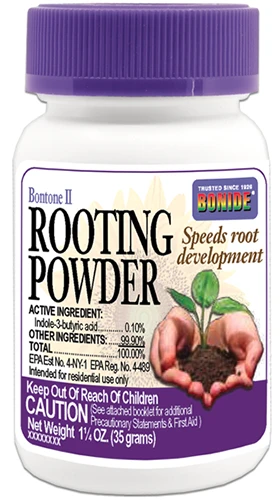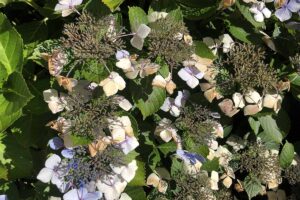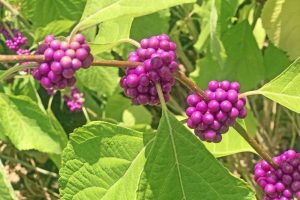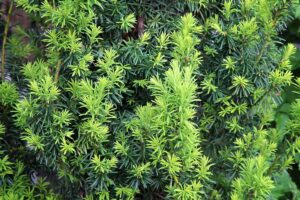Justicia brandegeana
I’ve always found arrangements of shrimp to be ultra alluring.
And when I first laid eyes on the shrimp plant, I knew deep within my seafood-loving bones that this enticing aesthetic could be applied to the landscape as well, and I was overjoyed.
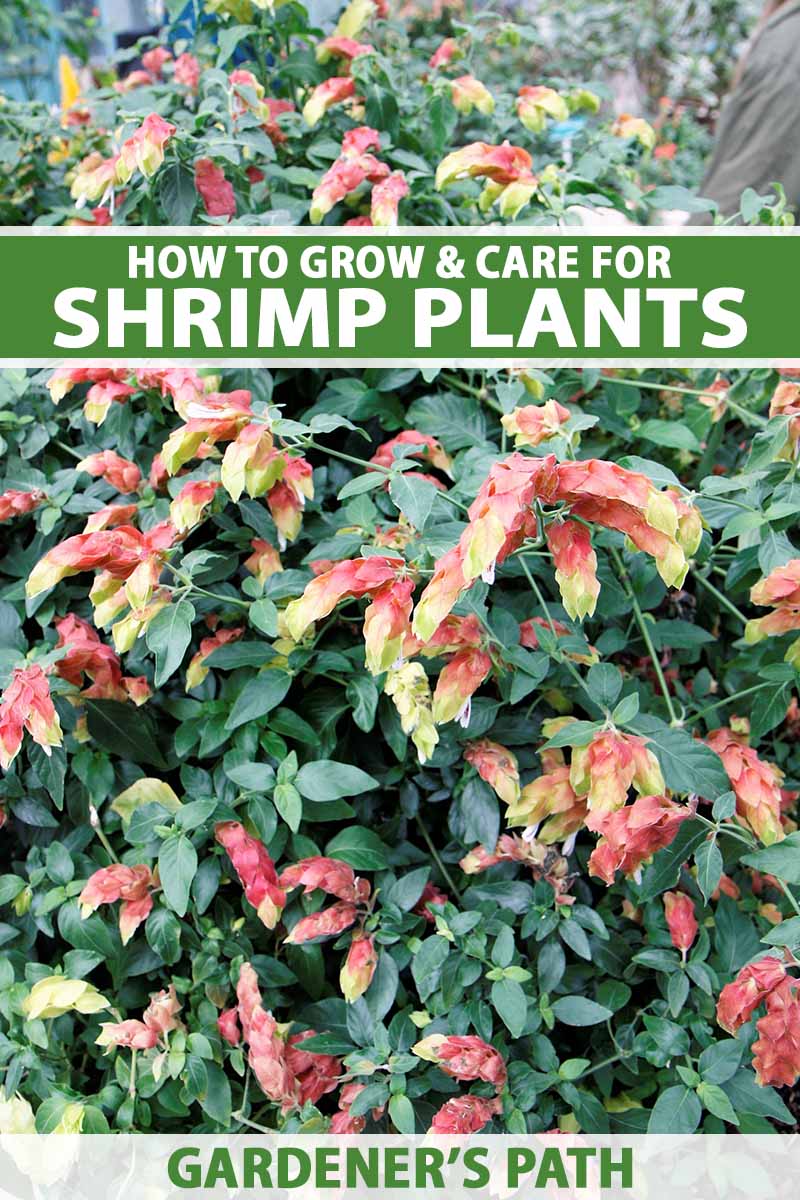
We link to vendors to help you find relevant products. If you buy from one of our links, we may earn a commission.
Okay, okay, I know it’s not actual shrimp that Justicia brandegeana is flaunting, but rather, shrimp-esque bracts.
But boy howdy, do they look similar, almost mouth-wateringly so. A real shrimp-oster, if you will.
The rest of this shrimp plant is also quite appealing.
From the lush evergreen leaves to its delightful form, this shrub is a full-blown smorgasbord of ornamental beauty, whether grown in-ground or in a container.
Just like putting actual shrimp on the barbie, growing J. brandegeana is well worth it.
A stunning specimen that’s easy to care for, the shrimp plant is enjoyable by all, regardless of shellfish allergy. And with our guide, you’ll learn how to cultivate yours the right way.
Here’s what’s comin’ atcha’:
What You’ll Learn
What Are Shrimp Plants?
A member of the Acanthus family alongside hummingbird plants, Persian shield, and Mexican petunias, J. brandegeana is a gorgeous evergreen shrub that hails from the tropics of Mexico.
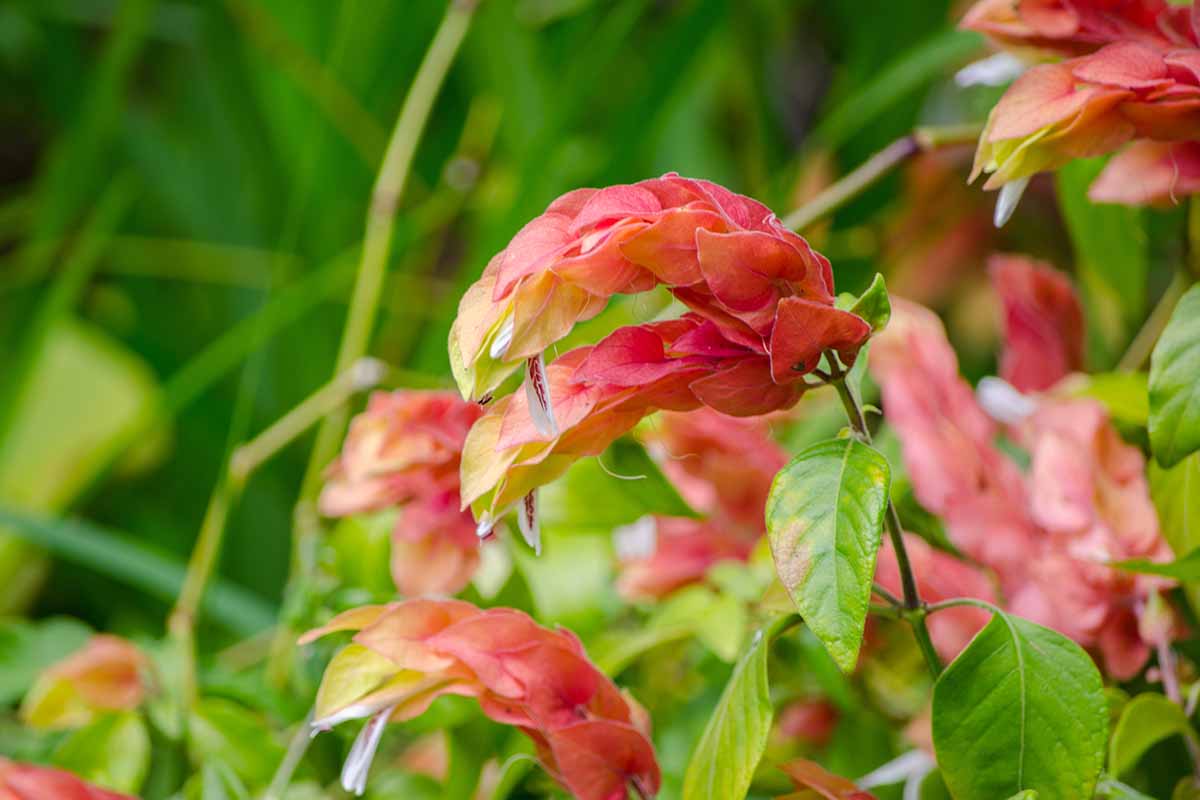
Hardy in USDA Zones 9 to 11, shrimp plants can reach heights and spreads of up to five feet in the amply hot and humid conditions of their native growing sites, but will likely be smaller if they’re grown in a more temperate climate or in containers.
With an open, sprawling habit and a tendency to expand via suckering, J. brandegeana boasts simple, oppositely-arranged, and lightly hairy leaves of an ovate shape with a bright green hue.
Towards the tip of the stems you’ll find the shrimp-like bracts that give the plant its name.
Starting out a dark red color, the arching bracts gradually shift in hue to bronze, and then abruptly to green as your eyes move further up the stem.
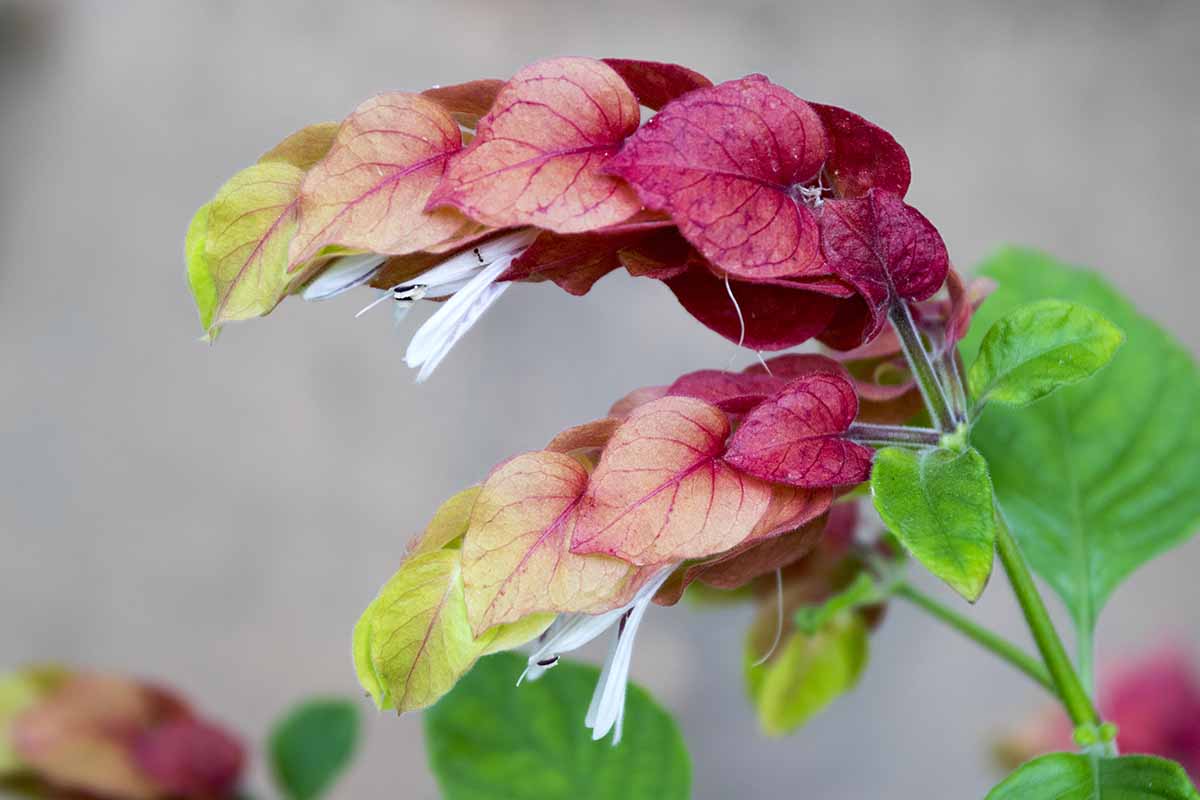
At the tip of the bracts hang skinny, fragrance-free flowers with white petals, a maroon throat, and purple anthers.
These flowers will bloom throughout the majority of the year in tropical conditions, from early spring to late fall. But in cooler and/or drier climates, the bloom period can be reduced to just the summertime.
The plant is monoecious, meaning a single specimen contains both male and female flowers.
Attracting hummingbirds and butterflies, the flowers are short-lived and quickly replaced throughout the blooming season.
After pollination, flowers give way to brown, non-showy fruit capsules, each containing tiny seeds.
Cultivation and History
In terms of having an impact on humanity, the shrimp plant isn’t as significant as, say, bamboo or indigo plants.
But it definitely contributed to the ornamental landscape and houseplant scene – the UK’s Royal Horticultural Society awarded J. brandegeana its prestigious Award of Garden Merit in 1913.
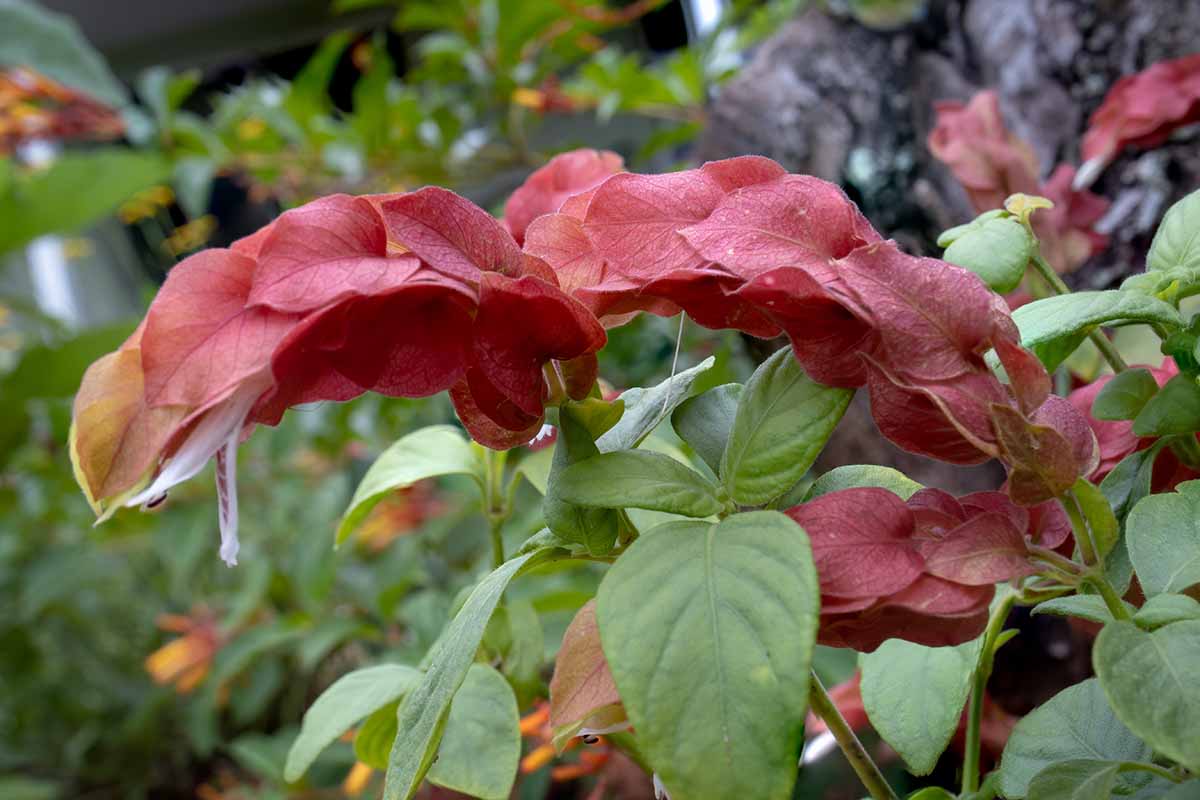
The genus and species names of J. brandegeana have some interesting backstories.
Justicia was named after the Scottish gardener James Justice, an influential horticulturist in the early 18th century who authored many practical writings on northern climate gardening and conducted many botanical experiments.
The specific epithet brandegeana owes its name to the botanist, plant collector, and surveyor Townsend S. Brandegee, who was a specialist on the flora of Mexico’s Baja region.
Another notable species in the Justicia genus is J. spicigera, aka Mexican honeysuckle, which you can read more about in our guide.
Shrimp Plant Propagation
Trying to acquire some shrimp plants? Your best avenues of doing so are propagation via stem cuttings, division, and transplanting.
From Stem Cuttings
In spring or summer, select healthy shoots to take four- to six-inch cuttings with a sterilized blade, and be sure to remove any blooms if they’re present.
Defoliate the bottom two inches of each cutting, making sure to leave at least two healthy leaves intact.
Dip the cut ends in a rooting hormone, such as this IBA powder from Bonide that’s available via Arbico Organics.
Bonide Bontone II Rooting Powder
Stick the hormone-powdered ends of each cutting into individual four-inch containers filled with a 50:50 mix of peat moss and perlite.
Moisten the media, then drape a clear plastic bag over each container to maintain ambient humidity. Make sure to keep the bag away from the cutting so it isn’t touching.
Place the containers in indirect light by a sunny window, and keep the growing medium moist as the cuttings take root. Occasionally lift the plastic coverings to increase airflow and check for mold.
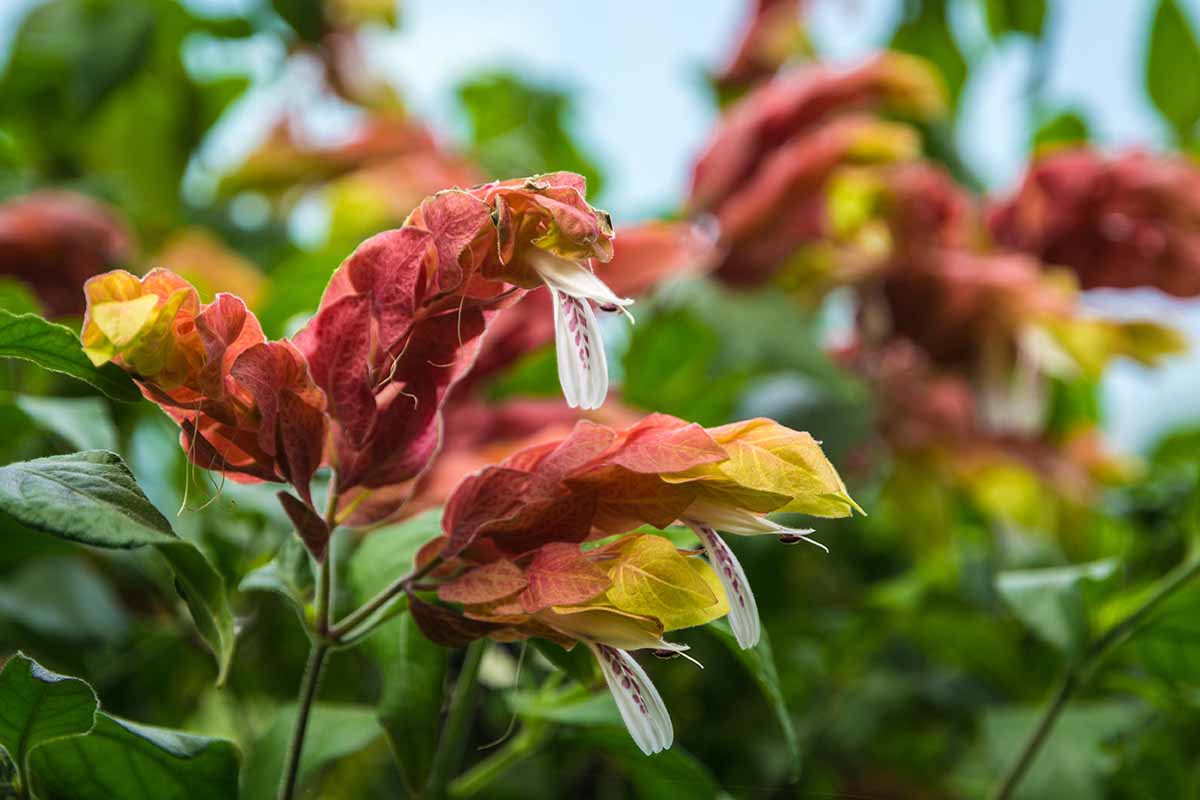
Rooting should occur in six to eight weeks. Remove the humidity bags and repot the cuttings as needed, keeping the media moist and providing indirect light all the while.
The following spring, the cuttings should be ready to harden off outdoors. Leave the containers outside in full sun to partial shade for 30 to 60 minutes before taking them back inside.
Every subsequent day, add 30 minutes to a full hour of outdoor time until the plants can handle a full day of outdoor exposure. At this point, they’re ready to transplant!
Via Division
Whether your potted J. brandegeana is in too small of a container or you simply want to break up a large in-ground clump, division is a fantastic way of making the most of the shrimp plants that you do have.
In springtime, select a large or cramped specimen to lift out of its planting site or container, making sure to water it well the day before you plan to divide.
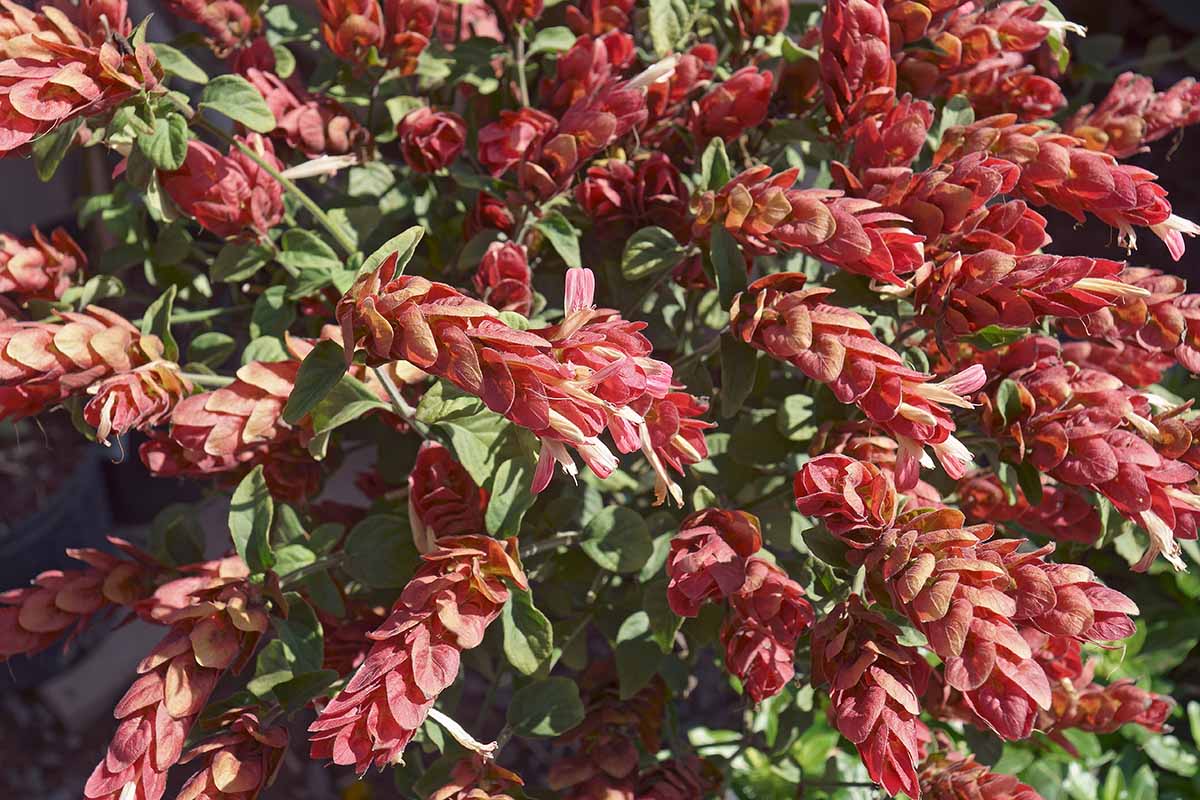
After gently lifting the plant from the ground or container – making sure to gingerly handle it and avoid damaging the root system – lay your plant across a spread-out tarp so you can see what you’re working with.
With a sharp and sterilized blade, cut the crown into two or more equally-sized sections, with roots and aboveground growth attached.
If necessary, a saw or pruners can be used to break up especially tough roots. Untangle the roots and shoots of each division from each other, and these pieces now have the green light for transplanting!
Via Transplanting
In your garden, prepare individual planting sites in well-draining, fertile soils with a pH of 6.0 to 7.0.
Space the sites about one to five feet apart, and ensure that the sites receive full sun to partial shade. Prepare holes the depth of and a bit wider than the transplants’ root systems.

For container-grown plants, select a well-draining pot that is about two inches larger in diameter than the transplant’s root system, add a 50:50 mix of peat moss and perlite, and then make ample room for the root system.
Lower the transplant into the hole, and then backfill with soil or potting media. For added fertility, work some organic matter such as compost into your backfill material. Water in around the root zone afterwards, and presto!
How to Grow Shrimp Plants
At this point, you’ve got a pretty J. brandegeana in the ground or a container. Let’s discuss how to keep it happy and healthy.
Climate and Exposure Needs
Provided that they’re growing in USDA Hardiness Zones 9 to 11, shrimp plants can thrive outdoors all year long.

But in more temperate gardens, they should be brought inside once temperatures start to dip below freezing.
If a bout of cold has suddenly struck without warning, then some thermal coverings will help your specimens conserve heat, buying them some time.
For a thermal polypropylene blanket that’s lined with grommets and available in multiple dimensions, try the Planket®, available from Amazon.

Whether it’s a seasonal houseguest or a full-time houseplant, an indoor J. brandegeana does well in temperatures ranging from 65 to 75°F.
Provide some ambient humidity by grouping it with other houseplants, keeping it in a well-lit bathroom, or placing a humidifier nearby.
For the best bract color, partial shade with protection from afternoon sun is ideal.
Full sun works, but it can leave the bracts looking a little sun-bleached. For proper indoor exposure, provide bright indirect light.
Soil Needs
The ideal soil was mentioned earlier: well-draining and fertile, with a pH of 6.0 to 7.0.
Post-planting, fertility can be supplemented by working an inch or two of organic matter into the soil or growing media each year in the spring.
Irrigation and Fertilization Needs
Like most members of the Acanthaceae family, shrimp plants prefer to sit in evenly-moist soils. But unlike most of its relatives, J. brandegeana can take a bit of afternoon dryness and wilting.
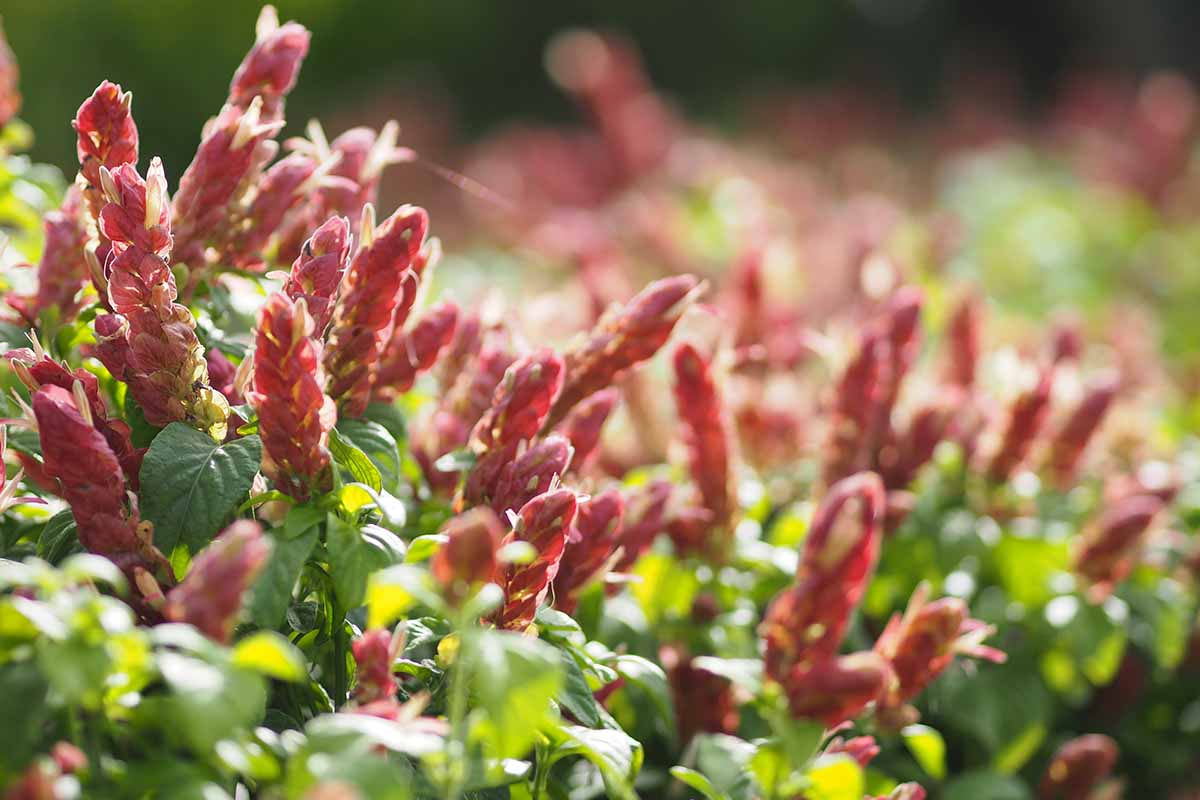
This isn’t ideal for blooming, though, so aim to add water whenever the surface of the soil or growing media feels dry to the touch.
Alongside organic matter amendments, an optimal fertilization plan entails applications of a balanced liquid NPK fertilizer, diluted down to half-strength and applied every two weeks throughout the growing season.
Growing Tips
- Partial shade exposure is best for blooming, although full sun works.
- Ensure that the soil or growing media is well-draining.
- Water whenever the surface of the soil or growing media feels dry to the touch.
Pruning and Maintenance
Any damaged, diseased, or dying tissues can be pruned away whenever you happen to notice them.
A more dedicated pruning session for shaping the plant how you like should take place before the growing season begins in spring.
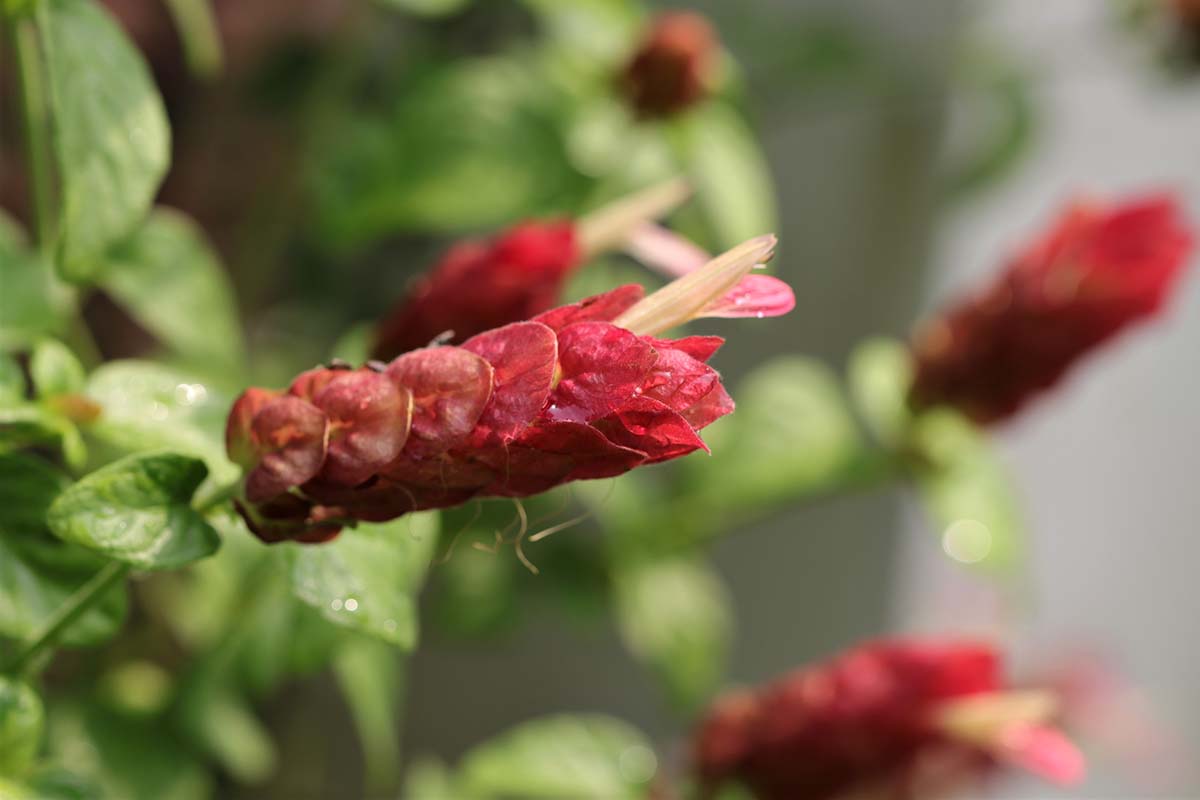
To encourage a more compact growth habit, feel free to pinch back the growth tips as desired. Spent flowers can be pinched as well to foster more frequent reblooming.
Read more about deadheading flowers in our guide.
Adding a couple inches of mulch atop the root zone can help tremendously with moisture retention and weed suppression.
For container-bound specimens in gardens to the north of Zone 9, don’t forget to move them inside before temperatures dip below freezing, and wait to bring them back outdoors until the return of warm weather.
Regardless of location, containerized J. brandegeana should be repotted as needed into a container about two inches wider than the root system within.
Where to Buy Shrimp Plants
Even for those who live in the tropics of Zones 9 to 11, J. brandegeana may not be the easiest to find.
Your best bets are local plant nurseries and online plant vendors based in warm regions of the country.
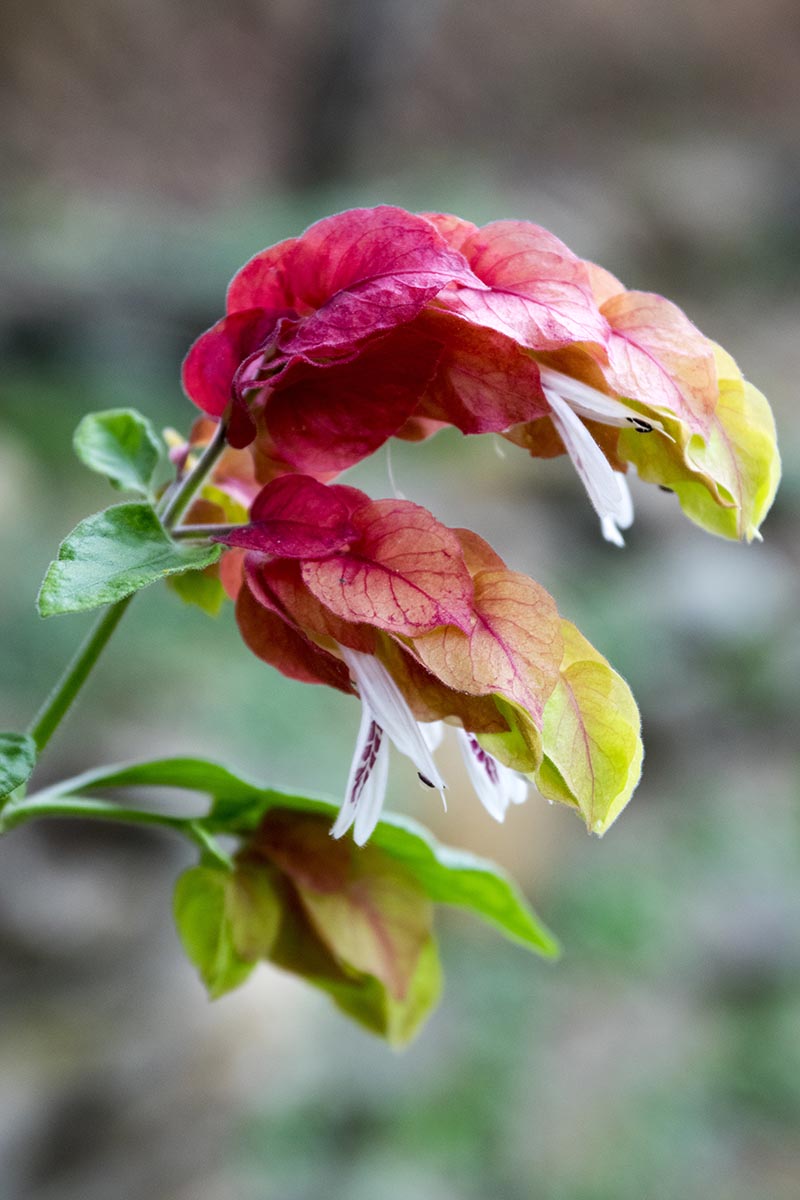
Online shopping is a nice way of acquiring plants that might otherwise be unavailable for in-person purchase in your area.
If you do decide to buy some J. brandegeana via the Internet, only do so via reputable vendors.
Once you’ve found your shrimp plant plug, make sure any purchases won’t be shipped during periods of potentially harmful temperature extremes.
And of course, you always have the option of consulting your IRL plant pals. If a fellow green thumb has a specimen for you to take a cutting or division from, then go for it!
Depending on the location and who’s going, plant swaps and horticultural shows may be helpful for acquiring some J. brandegeana, as well as some new gardening friends!
Managing Pests and Disease
Not many health issues plague shrimp plants, but that doesn’t mean they’re immune to problems. Let’s break down some potential threats, shall we?
Pests
Insects have an annoying tendency to spread pathogens as they feed, so cracking down on bugs usually includes cracking down on diseases, as an added bonus.
Spider Mites
Spider mites are itty-bitty pests that, if you care to look at them with a hand lens, have oval bodies covered with fine, bristly hairs.
But what’ll probably draw your eye to their presence is the fine webbing that they weave over infested structures.
Puncturing plant cells to feed, spider mites can cause foliage to exhibit stippling, revealing the tiny feeding spots, as well as chlorosis, browning, and leaf death.
Strong sprays of water can physically knock the pests off of surfaces, while applications of horticultural oil or insecticidal soap will actually smother them.

If you’re interested, Monterey sells 32-ounce, ready-to-spray bottles of horticultural oil that are available via Amazon.
Read more about managing spider mite infestations in our guide.
Whiteflies
Well, whiteflies live up to their name in appearance, albeit only halfway.
They look like tiny white moths that are covered with a fine, whitish powder… but technically, they’re not true flies.
As members of the Hemiptera order, they’re relatives of scale, mealybugs, and aphids.
Whiteflies have piercing-sucking mouthparts, which they use to extract essential botanical juices from leaves like a chlorophyll-flavored Capri-Sun. As a result of this feeding, leaves often exhibit chlorosis and wilting.
Upon their detection, whiteflies can be caught with yellow sticky traps, repelled with reflective mulch, or consumed by beneficial insects such as ladybugs, lacewings, and parasitic wasps.
Such beneficial insects can be purchased via Arbico Organics.
Learn more about whiteflies in our guide.
Disease
As any doctor, epidemiologist, or gas station bathroom attendant could tell you, disease can easily spread when conditions aren’t kept at least somewhat sterile.
Therefore, it would behoove you and your garden to utilize sterilized tools, clean soils and growing media, and disease-free stock.
Leaf Spot
A variety of different types of fungi and bacteria cause leaf spot diseases, but the universal synonymous symptom is, well, leaf spots.
Regardless of the shape, size, or color of the spots, these take up valuable photosynthetic real estate on the leaves, which can cause foliage loss and reduced vigor.
Adequate spacing, proper airflow, and avoidance of overhead irrigation can all reduce the chances of leaf spot. Rake up nearby detritus to limit potential overwintering sites for pathogens.
When applied prior to the appearance of symptoms, fungicides may offer some preventative protection.
Lightly spotted leaves can be left alone, while heavily spotted ones should be pruned and destroyed promptly.
Root Rot
Whether it’s abiotic or caused by a pathogen, root rot is primarily the result of excessively wet soils or growing mediums, whether due to too much watering, not enough drainage, or both.
When the roots are surrounded by excess moisture, they don’t receive the oxygen that they need, which can end up suffocating them.
Suffocated roots show their displeasure via necrosis and death, symptoms which aren’t observable aboveground.
But what does become apparent above the soil line is the resultant chlorosis, mushiness, reduced growth, and wilting in the shoots. Eventually, the entire plant could perish.
When root rot first becomes apparent, it’s essential to reduce irrigation and/or improve drainage, whichever is necessary.
To rejuvenate an afflicted plant, you can dig it up to trim away the rotted-out roots and a proportionate amount of shoots, but if more than half of the roots are done for, then the rest of the plant probably is, too.
Best Uses for Shrimp Plants
In the great outdoors, J. brandegeana is a stunning landscape specimen whose shrimpy bracts absolutely steal the show. In-ground, it’s gorgeous by itself or in a border line with others.
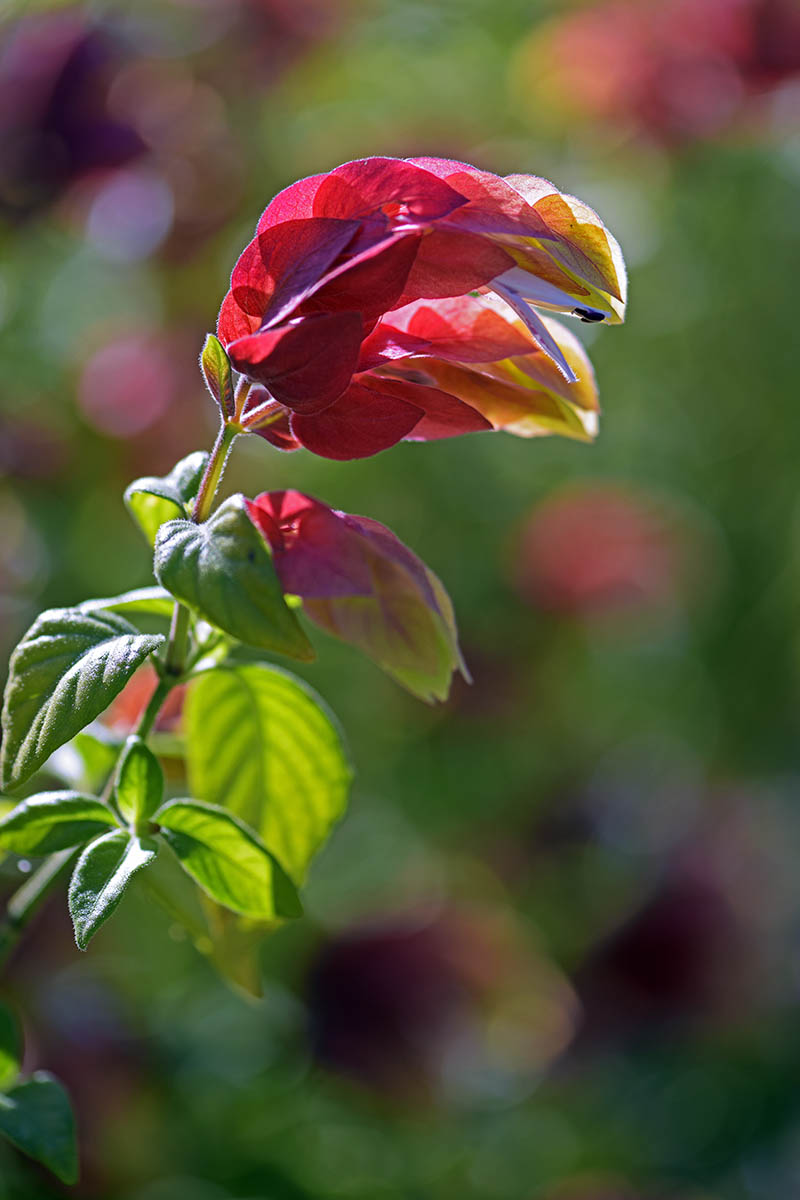
Containerized shrimp plants flaunt a versatile beauty, whether placed near a patio, by an entryway, or adjacent to some stairs.
But don’t forget – J. brandegeana can look right at home as a houseplant, too!
Since a shrimp plant in full bloom flaunts ample vibrant color, try pairing it with some tropical, foliage-dominant specimens such as Chinese evergreens, elephant ears, or snake plants.
Quick Reference Growing Guide
| Plant Type: | Broadleaf evergreen shrub | Flower/Foliage Color: | White (red, pink, bronze, green bracts)/green |
| Native to: | Mexico | Maintenance: | Moderate |
| Hardiness (USDA Zones): | 9-11 | Tolerance: | Heat, humidity, moderate drought |
| Bloom Time: | Summer (spring-fall in tropical climates) | Soil Type: | Fertile |
| Exposure: | Full sun, part shade | Soil pH: | 6.0-7.0 |
| Time to Maturity: | 5-10 years | Soil Drainage: | Well-draining |
| Spacing: | 1-5 feet | Attracts: | Butterflies, hummingbirds |
| Planting Depth: | Depth of root system | Uses: | Borders, houseplants, outdoor containers, specimen shrubs |
| Height: | 1-5 feet | Order: | Lamiales |
| Spread: | 1-5 feet | Family: | Acanthaceae |
| Water Needs: | Moderate | Genus: | Justicia |
| Common Pests and Disease: | Spider mites, whiteflies; leaf spot, root rot | Species: | Brandegeana |
Quite Shrimp-ressive
There’s no denying it: if you want your flora to resemble a certain culinary crustacean, you literally cannot do better than J. brandegeana.
Except for maybe crab leg orchids or hanging lobster claws, perhaps… but I could go on seafood tangents all day. We’re talking purely about shrimp here.
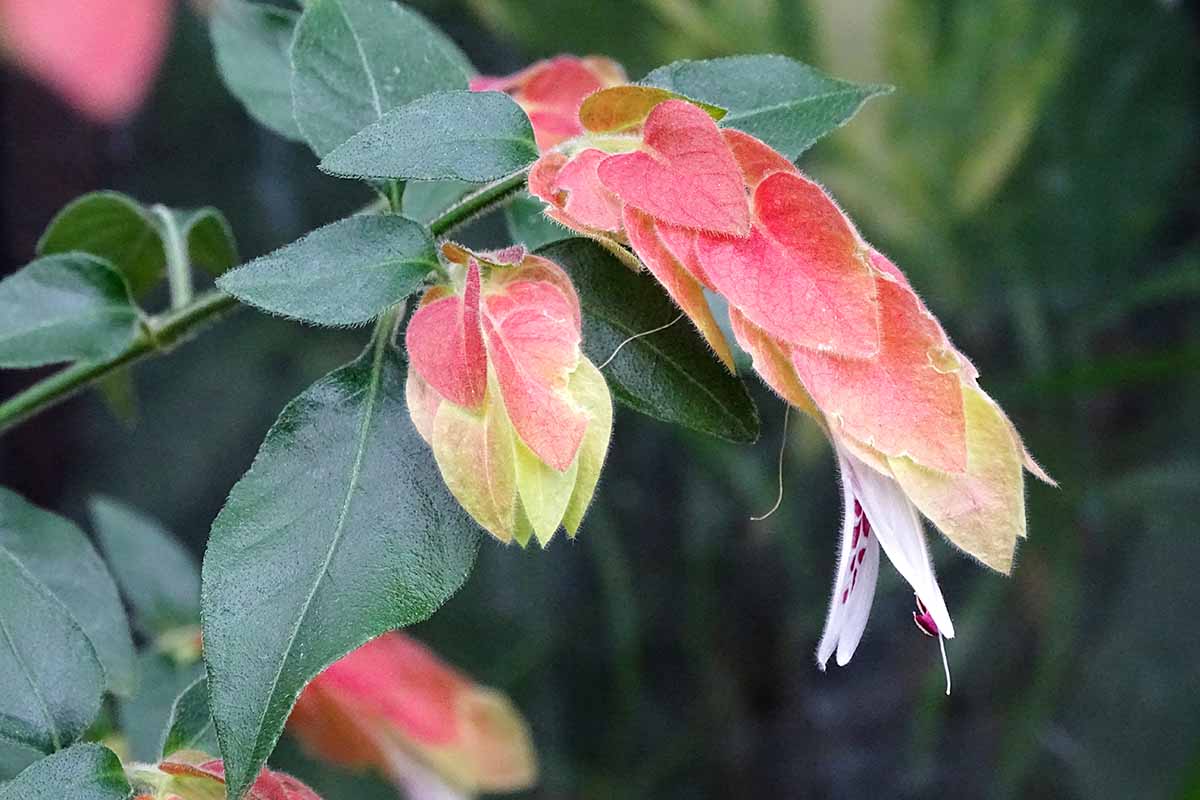
Easy to care for, pretty, and with a ton of placement options, the shrimp plant is a true gem to have around, both in- and out-of-doors. I’d recommend putting this bad boy at the top of your “plants-to-plant” list, if you have one. You won’t regret it.
Have any questions? Any J. brandegeana experiences of your own to share? The comments section is your oyster (which coincidentally goes great with shrimp).
Can’t get enough of ornamental plants with animal-like features? Indulge your inner wild side with these guides:
